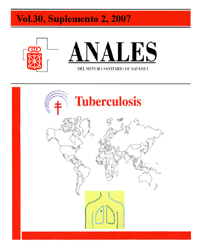Treatment of pulmonary tuberculosis
Keywords:
Tuberculosis, Tratamiento, Efectos secundarios, RetratamientosAbstract
The treatment of tuberculosis is important both to preserve the health of the patient and to prevent the spread of the disease amongst the population. Its bacteriological bases are found in the high number of bacillae existing in the majority of human TB lesions and the capacity to mutate of Mycobacterium tuberculosis when it achieves a high number of divisions; this makes it essential to associate drugs that avoid the selection of resistant mutants. In our setting the pharmacological therapy that has shown greatest efficacy consists in the association during two months of isoniacide, rifampicine and pyrazinamide followed by four additional months with the first two drugs. In general the first choice tuberculostatic drugs are well tolerated, but they can produce potentially serious secondary effects that it is necessary to understand and know how to manage. This article also describes how to act from the therapeutic point of view facing certain special situations and when the initial treatments have been abandoned or have failed. In the last five years in Navarre, there has been a significant increase in the presence of immigrants proceeding from developing countries with high rates of tuberculosis and primary resistances. Because of its specific socio-economic conditions and its cultural idiosyncrasy, this group frequently generates difficulties with respect to complying with the treatment, as well in follow-up and control. The treatment of tuberculosis must always be carried out by expert doctors.Downloads
Downloads
Published
How to Cite
Issue
Section
License
La revista Anales del Sistema Sanitario de Navarra es publicada por el Departamento de Salud del Gobierno de Navarra (España), quien conserva los derechos patrimoniales (copyright ) sobre el artículo publicado y favorece y permite la difusión del mismo bajo licencia Creative Commons Reconocimiento-CompartirIgual 4.0 Internacional (CC BY-SA 4.0). Esta licencia permite copiar, usar, difundir, transmitir y exponer públicamente el artículo, siempre que siempre que se cite la autoría y la publicación inicial en Anales del Sistema Sanitario de Navarra, y se distinga la existencia de esta licencia de uso.








